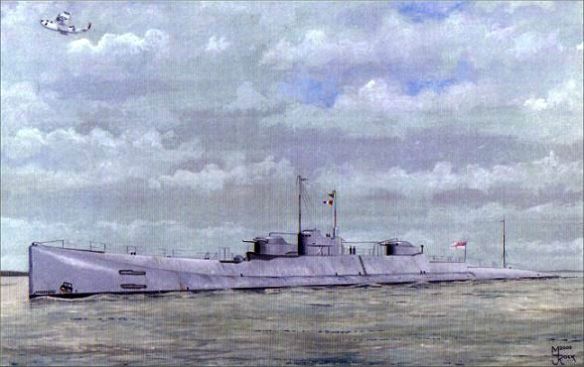When HMS X1 was launched, she was the largest submarine at sea, 3,600 long tons (3,700 t) submerged. She became the only warship designed and built for the Royal Navy after World War 1, to be scrapped before the start of World War II.
Constructed with a double hull, the external tanks carried most of the fuel, only 9% of the diesel being carried inside the pressure hull. X1, by any standards was a very large submarine and the pressure hull was divided into 10 separate watertight compartments.
Designed to attack any armed merchant ship by gun action alone, it was decided a 5.2″ calibre gun was required. These were manufactured at Woolwich and two twin mounted guns were fitted. Each gun was capable of firing 6 rounds per minute with a range of 17,288 yards.
To man both guns from the magazine to the firing control took no less than 50 crew.
The two admiralty diesel engines, both built at Chatham, were designed to produce 3,000 bhp each. The generators for charging the batteries, were driven by two auxiliary diesel engines. These were MAN-type 6 cylinder engines which had been taken from U 126 after this German boat had surrendered at the end of WW1.
Propulsion when submerged was supplied by four 600 bhp GEC Electric Motors. Each shaft being driven by two motors. These motors were the only part of the propulsion machinery that proved successful. Both the main and auxiliary diesels were constantly faulty and were the main reason for X1 being scraped.
| Name: | HM Submarine X1 |
| Builder: | HM Dockyard Chatham |
| Laid down: | 2 November 1921 |
| Launched: | 16 November 1923 |
| Commissioned: | December 1925 |
| Decommissioned: | 1936 |
| Fate: | Scrapped at Pembroke, 12 December 1936 |
| General characteristics | |
| Displacement: |
|
| Length: | 363 ft 6 in (110.79 m) |
| Beam: | 29 ft 9 in (9.07 m) |
| Draught: | 15 ft (4.6 m) |
| Propulsion: |
|
| Speed: |
|
| Endurance: |
|
| Test depth: | 350 ft (110 m) |
| Complement: | 111 (11 officers and 100 ratings) |
| Armament: |
|
Following her commissioning, X1 sailed for trials. In 1926 she sailed for the Mediterranean where she remained until 1930. On her return to the UK, X1 went into refit and in 1933 went into reserve. The razor blade factory beckoned and the submarine was scrapped in December 1936, eleven years after her commissioning.
X1 was the last submarine to have only a number until numbering of submarines began again at the beginning of WWII.
